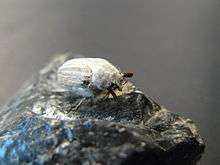Casey's June beetle
| Casey's June beetle | |
|---|---|
 | |
| Scientific classification | |
| Kingdom: | Animalia |
| Clade: | Euarthropoda |
| Class: | Insecta |
| Order: | Coleoptera |
| Family: | Scarabaeidae |
| Genus: | Dinacoma |
| Species: | D. caseyi |
| Binomial name | |
| Dinacoma caseyi | |
Casey's June beetle, Dinacoma caseyi, is a beetle in the scarab family (Scarabaeidae). It is listed as an endangered species with approximately 587 acres (237 hectares) of land as critical habitat in Riverside County, California.[1]
Taxonomy
The genus Dinacoma includes two described species, D. caseyi and D. marginata.[2] Delbert La Rue, a researcher experienced with the genus Dinacoma and a taxonomic expert stated, "Dinacoma caseyi is a distinct species morphologically and comprises its own species group—the caseyi complex—the other [species group] being the marginata complex which includes the bulk/remainder of the genus".[3] The Casey's June beetle was first collected in the city of Palm Springs, California, in 1916, and was later described by Blaisdell (1930, pp. 174–176) based on male specimens. This species measures 0.55 to 0.71 inches (in) (1.4 to 1.8 centimeters (cm)) long, with dusty brown or whitish coloring, and brown and cream longitudinal stripes on the elytra (wing covers and back).
Biology
Based on surveys conducted to assess the species' presence, both male and female Casey's June beetles emerge from underground burrows sometime between late March and early June, with abundance peaks generally occurring in April and May.[4] Females are always observed on the ground and are considered flightless.[5] La Rue (2006, p. 1) stated that "Female Dinacoma are very rare in collections. Females display an accentuated sexual dimorphism characterized by an enlarged abdomen, reduced legs and antennae, and metathoracic wing reduction and venation. These characters are likely adaptations to flightlessness and a fossorial biology." During the active flight season, males emerge from the ground and begin flying near dusk.[6] Males are reported to fly back and forth or crawl on the ground where a female beetle has been detected.[7] Cornett (2003, p. 5) theorized that after emergence, females remain on the ground and release pheromones to attract flying males. After mating, females return to their burrows or dig a new burrow and deposit eggs. Excavations of adult emergence burrows revealed pupal exuviae (casings) at depths ranging from approximately 4 to 6 in (10 to 16 cm).[8]
The larval cycle for the species is likely 1 year, based on the absence of larvae (grubs) in burrows during the adult flight season.[3] The food source for Casey's June beetle larvae while underground is unknown, but other species of June beetle are known to eat "plant roots or plant detritus and associated decay organisms".[3] La Rue (2006, pp. 1–2) stated, "[Casey's June beetle] exhibits no specific host preferences, and larvae likely consume any available organic resources— including [layered organic debris]— encountered within the alluvial habitat." Specific host plant associations for Casey’s June beetle are not known. Although visual surveys have detected a concentration of emergence burrows in the vicinity of a number of species of woody shrub in Palm Canyon Wash, this may be due to low soil disturbance by vehicles, foot traffic, and horses near woody vegetation.[6]
Notes
- 1 2 Fish and Wildlife Service 2011, p. 58954.
- ↑ Blaisdell 1930, pp. 171–176.
- 1 2 3 La Rue 2006, p. 1.
- ↑ Duff 1990, p. 3; Barrows 1998, p. 1
- ↑ Duff 1990, p. 4; Frank Hovore and Associates 1995, p. 7; Hovore 2003, p. 3
- 1 2 Hovore 2003, p. 3.
- ↑ Duff 1990, p. 3.
- ↑ Frank Hovore and Associates 1995, p. 6.
| Wikimedia Commons has media related to Dinacoma caseyi (Casey's June beetle). |
References
![]()
- Anderson, A. (2006), Notes from the UCR Entomology Museum visit Cited in Fish and Wildlife Service (2007)
- Blaisdell, F.E. (1930), "Revision of the genus and species of Dinacoma with description of a new species (Coleoptera: Scarabaeidae)", Pan-Pacific Entomologist, 6: 171–177
- Cornett, J. W. (2003), Casey’s June beetle survey and habitat analysis for the Palm Springs Classic Project, located within the City of Palm Springs, Riverside County, California. Report prepared for the Keith Companies, Palm Desert, California Cited in Fish and Wildlife Service (2007)
- Duff, R. (1990), Dinacoma caseyi: Current Status of Endangered Species. Unspecified submission recipient Cited in Fish and Wildlife Service (2007)
- Fish and Wildlife Service (5 July 2007), "Endangered and Threatened Wildlife and Plants; 12-Month Finding on a Petition To List the Casey's June Beetle (Dinacoma caseyi) as Endangered With Critical Habitat", Federal Register, 72 (128): 36635–36646, 72 FR 36635
- Fish and Wildlife Service (22 September 2011), "Endangered and Threatened Wildlife and Plants; Determination of Endangered Status for Casey's June Beetle and Designation of Critical Habitat", Federal Register, 76 (184): 58954–58998, 76 FR 58954
- Frank Hovore and Associates (1995), Report of field surveys: Coachella Valley Multispecies HCP, Invertebrates - Palm Springs June beetle (Dinacoma caseyi). Unspecified submission recipient
- Hovore, F (2003), Report of focused surveys for Casey’s June beetle: Smoketree Ranch and vicinity, prepared for Krieger & Stewart, Inc., Riverside, California. Cited in Fish and Wildlife Service (2007)
- La Rue, Delbert (13 June 2006), Electronic mail communication to Alison Anderson, Entomologist, Carlsbad Fish and Wildlife Office, Carlsbad, CA . Cited in Fish and Wildlife Service (2007)
- LeRoy, N.P; Allan, J.D.; Bain, M.B.; Karr, J.R.; Prestegaard, K.L.; Richter, B.D.; Sparks, R.E.; Stromberg, J.C. (1997), "Natural Stream Flow", BioScience, 47: 769–784, doi:10.2307/1313099
